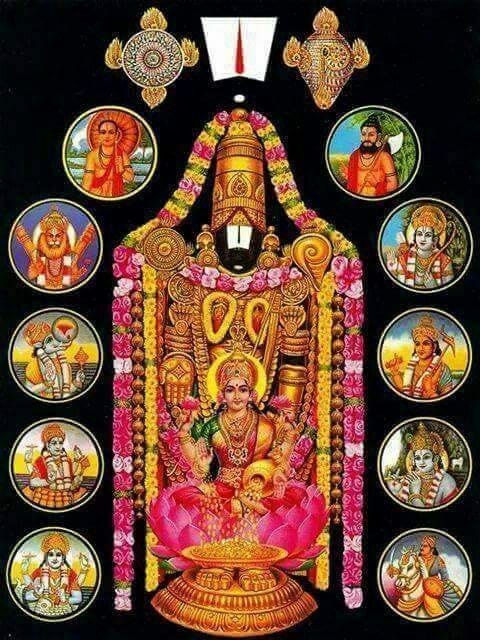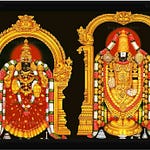Continuing on from last time, we will look at two more verses today which are also both simply lists of names (or, more properly, invocations, sambodhanas) of Lord Śrīnivāsa.
Kandarpa-darpa-hara(!)[-]sundara-divya-mūrte! kāntā-kucâmburuha-kuṭmala-lola-dṛṣṭe! | kalyāṇa-nirmala-guṇâ-ākara! divya-kīrte! Śrī-Veṅkaṭâcala-pate! tava suprabhātam || (VSu 23) mīnâ-ākṛte! kamaṭha! kola! Nṛsiṃha! varṇin! svāmin!! paraśvatha-tapo-dhana! Rāma-candra! Śeṣâ-aṃśa-Rāma! Yadu-nandana! Kalki-rūpa! Śrī-Veṅkaṭâcala-pate! tava suprabhātam || (VSu 24) कन्दर्प-दर्प-हर(!)(-)सुन्दर-दिव्य-मूर्ते ! कान्ता-कुचा-ऽऽम्बुरुह-कुट्मल-लोल-दृष्टे ! कल्याण-निर्मल-गुणाकर ! दिव्य-कीर्ते ! श्रीवेङ्कटाचल-पते! तव सुप्रभातम् ॥ मीना-ऽऽकृते ! कमठ ! कोल ! नृसिंह ! वर्णिन् ! स्वामिन् ! परश्वथ-तपो-धन ! राम-चन्द्र ! शेषा-ऽंश-राम ! यदु-नन्दन ! कल्कि-रूप ! श्रीवेङ्कटाचल-पते! तव सुप्रभातम् ॥
[23] Your Divine form is beyond beautiful, overcoming the pride even of Kāmadeva; Your gaze is forever fixed upon the lotus-blossom bosom of Your beloved wife; O ocean of flawless, purely auspicious virtues! Your Divine glory is all-pervading: O Lord of the sacred mountain wealth-weaving, sin-cleaving Veṅkaṭam, a blessed morning unto You! [24] Fish-shaped Lord, Cosmic Turtle, Bhū-bearing Boar, Man-lion, Brahmin boy, My Lord! Axe-wielding ascetic The glorious Rāma Balarāma, part-incarnation of Ādi-Śeṣa Kṛṣṇa, delighter of the Yadu clan Lord Kalkin: O Lord of the sacred mountain wealth-weaving, sin-cleaving Veṅkaṭam, a blessed morning unto You!
We can see even from the translations that Verse 23 and Verse 24 have their own internal coherence. While Verse 24 is obviously a summary of the Daśâvatāra (the Ten Key Descents of the Divine), Verse 23 is all about the beauty of the Divine. And unlike last time,
Verse 23: On Divine Beauty
The names in verse 23 are all related to the infinite beauty and attractiveness of Lord Śrīnivāsa, and to the intra-Divine relationship between the Lord and the Lady. These names, as we will see, are rather more complex than the names in verse 22.
The first line can either be treated as a single name, or as two separate names:
Treated as two separate names, these are:
Kandarpa-darpa-hara “the one who takes away the pride of Kāmadeva”: The choice of the god of love as the comparand here is significant, as Kāma (at least before his body was incinerated by Śiva) was regarded as the exemplification of physical beauty. Thus, we can understand that the supernatural physical manifestation of the Lord far exceeds in beauty any natural embodied form. But the specific name chosen for Kāma here, Kandarpa, is also significant because it replicates the word darpa within it.1 Thus, for those who have an inflated sense of self, an encounter with the infinite superiority (paratva) of the Divine can be humbling.
sundara-divya-mūrti “the one whose divine embodied form is beautiful”: The word mūrti applies both to the temple icon of Lord Veṅkaṭeśvara, as well as to the physical embodiments of the Lord in His various avatāras. But even if this form looks like a normal physical embodiment, this name makes clear both that the Divine’s embodiments are full of beauty, and are also intrinsically divine, supernatural forms.
If we so choose, we can even split this up into two separate names as well, Sundara and Divya-mūrti. The first of these is in fact a name of the Lord from the Viṣṇu-Sahasranāma.2
Treated as a single name, this is the line-long Kandarpa-darpa-hara-sundara-divya-mūrti, which combines the two above meanings and thus creates a causal link between them: the Lord’s divine, embodied form is infinitely more beautiful than Kāma’s body, and hence overwhelms his pride.
The second line of the verse is unambiguously a single name which grants us a glimpse into the deepest of cosmic secrets: the inextricably intertwined intra-Divine intimacy of the Supreme Lord and the Supreme Lady. I will therefore refrain from delving too deeply into this name, and will toss out just one idea for us to ponder over in private:
I like to think of this name as depicting the converse of the image portrayed in Swāmī Deśikar’s opening verse of the Tattva-muktā-kalāpa (discussed in a footnote in this series a while back): while in that name it is the blue-lotus beauty of the Goddess’s eyes that reflects in and magnifies the blue-lotus beauty of the Lord’s body, here it is the red-lotus-bud beauty of the Goddess’s bosom that reflects in and magnifies the red-lotus-petal beauty of the Lord’s eyes. Thus, the Supreme Lord and the Supreme Lady are immersed in each other and reflected in each other ad infinitum.The third line of the verse can also potentially be understood as a single name, though we’re probably better off thinking of it as two separate names.
The first is kalyāṇa-nirmala-guṇâ-’’kara (“ocean of flawless, purely auspicious virtues”). This name recalls to mind the name Dayā-’’di-guṇâ-’mṛtâ-’bdhi from verse 21. What differentiates this name is its emphasis on the simultaneous auspiciousness and flawlessness of all of the Lord’s qualities. There are clear echoes here of a fundamental Śrīvaiṣṇava text, which we will see below.
The second is divya-kīrti (“one whose glory is divine”). To understand this name, we should think about what fame means, particularly in a pre-modern world without Google Adwords or a planet-scale marketing industry. Fame in such a world meant that people knew your name, your attributes, and your stories; fame meant that people remembered your achievements and your character even in your absence. Fame is thus, in effect, accurate knowledge of an object even in the absence of the object. But how does this apply in the case of the Lord, who is in fact omnipresent? We can think of it in two ways:
Firstly, awareness of the Divine is also all-pervading, to people everywhere and everywhen, in different forms that are conducive to their beliefs and their capacities.
Secondly, and more specifically to Lord Veṅkaṭeśvara, people sing His glories everywhere, so that knowledge of His name and His fame truly does pervade the earth—much like His temples and the recitation of His Suprabhātam in M.S. Subbulakshmi’s rendition.
And if we treat this as a single name, we can combine their meanings with a causal link: His glory is justifiably all-pervading because He (along with His Śrī) is utterly unique in being purely auspicious without the slightest whiff of a flaw.
Verse 24: On Divine Descents

Where Verse 23 displayed long and complex names for the Lord, verse 24 goes with short, crisp names instead—and it needs to, as it is trying to fit in all ten names of the Daśâvatāras in three lines!
Since the Ten Divine Descents of the Lord are well-known, and since most of these names are quite transparent, I will restrict myself to offering just a few points of observation on some specific names here:
The Boar
The name Kola (“boar”) is used for the third avatāra instead of the more common name, Varāha. There are two beautiful reasons for this.
Firstly, the name calls to mind one of the most exquisite pāśurams from the Tiru-vāy-mŏḻi of Nammāḻvār, almost at the very end of the whole work, in which he refers to the Divine Boar as kōla-varāha and thus also puns on the Tamil meaning of the world kōla as well:
Kōla-malarp-pāvaikk’ anb’ āgiya vĕn anbēyō! nīla-varai yiraṇḍu piṟai kavvi nimirndad’ ŏppa kōla-Varāham ŏndṟāy Nilam kōṭṭ’ iḍaik koṇḍa vĕn-dāy! nīlak kaḍal kaḍaindāy! unnai pĕṯṯṟ’ inip pōkkuvanō? (TVM 10.10 (Muniyē).7)
My beloved Lord who is the beloved of the lovely lotus-Lady Lakṣmī! My Father who lifted up the Earth upon His tusk in the form of the Magnificent Boar resembling a sapphire mountain bearing two crescent moons! You churned the ocean turned blue: Having attained You, Will I now let You go?
Secondly, the non-use of the name Varāha specifically draws our attention to its importance in the context of Lord Śrīnivāsa: the shrine to Lord Bhū-Varāha Swāmī predates the shrine to Lord Veṅkaṭeśvara in this region, and it is therefore customary to pay respects to Lord Bhū-Varāha before worshipping Lord Veṅkaṭeśvara.
The Lord
The name Svāmin (“Lord!”) occurs right in the middle of the ten names, splitting them into two equal pentads. The effect is beautifully captured by the image above, with Veṅkaṭeśvara Swāmī in the middle and the two sets of avatāras on either side. The first set of five avatāras can be thought of in a more cosmic way, while the second set of five is more historical, more anchored in the specifically human, so to speak.
The Ploughbearer
The divine avatāra of Balarāma is referred to here specifically as being an aṃśa, or partial descent, of Ādi-Śeṣa, the Cosmic Serpent. This name is specifically relevant to Lord Śrīnivāsa because, of course, He is Śeṣâdri-śekhara-vibhu, the “all-pervading Almighty atop the mountain-form of the Cosmic Serpent”.
The connection between Verses 23 and 24
What might be the connection between these two adjacent verses? Sure, they both describe the Supreme Lord Śrīman-Nārāyaṇa, but is there anything deeper going on here? I’d like to propose that the connection between these two verses is seen in the grand, elaborate opening sentence of Swāmī Rāmānujar’s Gītā-Bhāṣya.3
While I will not attempt to translate the whole sentence here (it is worthy of a whole separate post of its own), I will highlight a few salient points from the sentence that illustrate the connection between these two verses:
The sentence repeatedly emphasizes the fact that the Supreme Absolute is endowed with unending, uncountable positive qualities and is entirely free of anything that might even carry the slightest scent of a flaw or a deficiency.
Primary among these qualities are Divine Compassion, accessibility, and love for us creatures.
As a natural consequence, the Absolute Divine descends4 repeatedly into different realms and different contexts, all in forms that are comprehensible and accessible to the devotees in those situations, without thereby compromising in any way on the Divine essence.
And even further, the Divine also makes accessible to us the means to approach the Divine, in the form of Bhakti-yoga supplemented by knowledge and action, as conveyed in the Śrīmad-Bhagavad-Gītā.5
Appendix: Swāmī Deśikan’s two stotras on the Daśâvatāra
The Daśâvatāra-Stotra
The most likely inspiration for Verse 24, in style and in theme, is the penultimate verse (or dhyāna-śloka) of Swāmī Nigamānta-Mahādeśikar’s Daśâvatāra-Stotra. In this fairly short poem, he describes the Lord’s avatāras as being acting roles (bhūmikā) donned by Lord Raṅganātha of Srirangam, in which He is always accompanied by His spouse, Raṅganāyakī Tāyār.
The penultimate verse reads:
«icchā-mīna!» «vihāra-kacchapa!» «mahā-
potrin!» «yadṛcchā-hare!»
«rakṣā-vāmana!» «roṣa-Rāma!» «karuṇā-
Kākutstha!» «helā-halin!» |
«krīḍā-vallava!» «kalka-vāhana-daśā-
Kalkinn!» iti praty-ahaṃ
jalpantaḥ puruṣāḥ punanti bhuvanaṃ
puṇyaûgha-paṇyâpaṇāḥ || (DAS 12)“A fish, of His own volition!” “A tortoise, for His enjoyment!” “A colossal boar!” “A lion, utterly unpredictable!” “A dwarf, for protection!” “Rāma the furious!” “Born into the Kākutstha dynasty, out of compassion!” “A wielder of the plough, out of play!” “A playful cowboy!” “Rider of a white horse!”: People who prattle these names daily (even without knowing their meanings) are the ones who, with their huge hoards of merit, purify the earth.
From the Dayā-Śataka
But Swāmī Deśikar has yet another mini-stotra dedicated to the Daśâvatāra, embedded this time into his Dayā-śataka that celebrates the Compassion personified of Lord Veṅkaṭeśvara. Verses 82 through 90 of the song, all set in the lilting Pṛthvī meter6, sing of the role of Dayā Devī in each of the avatāras of Lord Veṅkaṭeśvara.
There are two obvious ways in which this embedded Daśâvatāra-stotra is echoed in this particular verse. The first is the fact that Paraśu-Rāma is referred to by the same name in both places (in this verse and in DAS 83: paraśvatha-tapodhana “axe-wielding ascetic whose austerity is his wealth”. This is an uncommon and unusual phrasing, so that this connection between the two texts can be cleanly made.
The second connection comes from the verse that sings of the role of Dayā Devī in the Kṛṣṇa avatāra, and which further underscores the link between the two verses we are discussing today with Bhagavad Rāmānujar’s Gītā-Bhāṣya:
prabhūta-vibudha-dviṣad- -bharaṇa-khinna-Viśvaṃbharā- -bharâ-apanayana-cchalāt tvam avatārya Lakṣmī-dharam | nirākṛtavatī Daye! nigama-saudha-dīpa-śriyā vipaścid-avigītayā jagati Gītayâ andhaṃ tamaḥ || (DŚ 89)
On the pretext of easing the burden of the All-bearing Earth-goddess bent over by the weight of innumerable god-hating demons, You sent down the Lord who bears Lakṣmī on His chest, o Lady Compassion! and dispelled through the Bhagavad-Gītā celebrated by the wise as a lamp-light for the immortal mansion of the Vedas the blinding dark engulfing our world!
This is a truly magnificent verse, not just for its sound effects,7 or for its remarkable choice of words,8 but for its glorious exposition of the power of Divine Compassion: Where Bhagavad Rāmānujar says that it was the Divine Lord who sent down the Gītā, here Swāmī Deśikar says that it is the Lord’s Compassion personified (the greatest of His qualities) who sent the Lord Himself down as Kṛṣṇa!
|| Śrī-Padmāvatī-nāyikā-sameta-Śrī-Śrīnivāsa-parabrahmaṇe namaḥ ||
This name for Kāma is given an etymological justification in the Kathā-sarit-sāgara in the story that tells of his birth:
«kaṃ darpayāmî» ’ti madāj jāta-mātro jagāda ca | tena «Kandarpa»-nāmānaṃ taṃ cakāra Catur-mukhaḥ }| (KSS 3.64.4
“Whom do I drive mad?”, he said, out of arrogance, even though he had just come into existence. Hence Four-faced Brahmā named him Kandarpa.
As before, the versified etymology of the name Sundara based on Parāśara Bhaṭṭar’s commentary on the Viṣṇu-Sahasranāma is given below. It is likely to feel quite counter-intuitive to us at this point, as this name occurs within a cluster of names that Parāśara Bhaṭṭar interprets as a description of the Buddha or of other similar figures who conquered asuras by deluding them into destruction:
[n#797] sa syāt Sundara uddiṣṭas teṣāṃ dṛṣṭi-manoharaḥ |
He is called Sundara for He enchants the vision of the asuras into thinking He (as the Buddha) has transcended saṃsāra.
Here is the whole sentence, untranslated, but with key phrases bolded:
Śriyaḥ patiḥ nikhila-heya-pratyanīka-kalyāṇaîka-tānaḥ svêtara-samasta-vastu-vilakṣaṇâ-ananta-jñanâ-ānandaîka-sva-rūpaḥ svābhāvikâ-anavadhikâ-atiśaya-jñāna-balaîśvarya-vīrya-śakti-tejaḥ-prabhṛty-asaṃkhyeya-kalyāṇa-guṇa-gaṇa-mahôdadhiḥ svābhimatâ-anurūpaîka-rūpâ-acintya-divyâ-adbhuta-nitya-niravadya-niratiśayaûjjvalya-saundarya-saugandhya-saukumārya-lāvaṇya-yauvanâ-ādy-ananta-guṇa-nidhi-divya-rūpaḥ svôcita-vividha-vicitrâ-anantâ-āścarya-nitya-niravadyâ-aparimita-divya-bhūṣaṇaḥ svânurūpâ-asaṃkhyeyâ-acintya-śakti-nitya-niravadya-niratiśaya-kalyāṇa-divyâ-āyudhaḥ svâbhimatâ-anurūpa-nitya-niravadya-svarūpa-rūpa-guṇa-vibhavaîśvarya-śīlâ-ādy-anavadhikâ-atiśayâ-asaṃkhyeya-kalyāṇa-guṇa-gaṇa-Śrī-vallabhaḥ sva-saṅkalpâ-anuvidhāyi-svarūpa-sthiti-pravṛtti-bhedâ-aśeṣa-seṣataîka-rati-rūpa-nitya-niravadya-niratiśaya-jñāna-kriyaîśvaryâ-ādy-ananta-guṇa-gaṇâ-aparimita-sūribhir anavaratâ-abhiṣṭuta-caraṇa-yugalaḥ vāṅ-manasâ-aparicchedya-svarūpa-svabhāvaḥ svôcita-vividha-vicitrâ-ananta-bhogya-bhogôpakaraṇa-bhogasthāna-samṛddhâ-anantâ-āścaryâ-ananta-mahā-vibhavâ-ananta-parimāṇa-nitya-niravadyâ-akṣara-parama-vyoma-nilayaḥ vividha-vicitrâ-ananta-bhogya-bhoktṛ-varga-paripūrṇa-nikhila-jagad-udaya-vibhava-laya-līlaḥ paraṃ brahma Puruṣöttamo Nārāyaṇaḥ Brahmā-ādi-sthāvarâ-antam akhilaṃ jagat sṛṣṭvā, svena rūpeṇâ avasthito Brahmā-ādi-deva-manuṣyāṇāṃ dhyānâ-ārādhanā-ādy-agocaraḥ apāra-kāruṇya-sauśīlya-vātsalyaûdārya-mahôdadhiḥ svam eva rūpaṃ tat-tat-sajātīya-saṃsthānaṃ sva-svabhāvam ajahad eva kurvan teṣu teṣu lokeṣv avatīryâ avatīrya, tais tair ārādhitas tat-tad-iṣṭânurūpaṃ dharmârtha-kāma-mokṣâkhyaṃ phalaṃ prayacchan bhū-bhārâ-avatāraṇâ-apadeśenâ asmad-ādīnām api samāśrayaṇīyatvāyâ avatīryô ūrvyāṃ sakala-manuja-nayana-viṣayatāṃ gataḥ parāvara-nikhila-jana-mano-nayana-hāri-divya-ceṣṭitāni kurvan Pūtanā-Śakaṭa-YamalÂrjunâ-Ariṣṭa-Pralamba-Dhenuka-Kāliya-Keśi-Kuvalayâpīḍa-Cāṇūra-Muṣṭika-Tosala-Kaṃsâ-ādīn nihatyâ, anavadhika-dayā-sauhārdâ-anurāga-garbhâ-avalokanâ-ālāpâ-amṛtair viśvam āpyāyayan niratiśaya-saundarya-sauśīlyâ-ādi-guṇa-gaṇâ-āviṣkāreṇâ Akrūra-Mālākārâ-ādīn parama-bhāgavatān kṛtvā, Pāṇḍu-tanaya-yuddha-protsāhana-vyājena parama-puruṣārtha-lakṣaṇa-mokṣa-sādhanatayā Vedântôditaṃ sva-viṣayaṃ jñāna-karmâ-anugṛhītaṃ Bhakti-yogam avatārayām āsa |
While the root-meaning of words like avatāra, avataraṇa, and so on does indeed convey the sense of “descent”, literally, “crossing down from above”, I wonder if, in the Hindu context, given the omnipresence of God and the omnisaturation of all beings with the Divine, it might be better to translate this word as “precipitate”. It would simultaneously bring to mind the downward movement of rain from the heavens, suggest the life- and joy-giving power of the rains, and also capture the image from chemistry labs of precipitates coalescing from a solution and aggregating at the bottom of the container.
The word used by Bhagavad Rāmānujar in this sentence for the Divine making the Gītā available to all is avatārayām āsa, the perfect (Liṭ) of the causative (ṇic) of the same root from which avatāra is derived. Literally, the Lord caused the path of Bhakti-yoga to “cross down” / “precipitate” in the form of the Bhagavad-Gītā. This is a very unusual phrasing in the Hindu context, but as it so happens, much more common in the Jewish and Muslim contexts.
Thus, in the Hebrew Bible, the verb Y-R-D “to descend” is used multiple times in the Book of Exodus to describe Moses’s encounter with the Divine on Mt Sinai and his proclamation of the Ten Commandments to the Israelites. It thus also means “revelation”.
In the Islamic context, the word tanzīl (the Class II verbal noun, or maṣdar, of the root N-Z-L “to descend”) is very commonly used to refer to the revelation of the Qur’ān. The Class II form of a root is the causative form, and thus exactly parallels the use of the causative in the Sanskrit avatārayām āsa.
This 19-syllabled meter is defined—and exemplified—as follows:
Ja-SauJa-Sa-Ya-Lā vasu-/-graha-yatiś ca PṛthvīGuruḥ
See, for instance, the repetition of words like bharaṇa, bharā, and bhara at the very beginning of the verse, or the rhyme between avigītayā and Gītayā, or the alliteration betweeen nirākṛtavatī and nigama.
For just one example, consider the word saudha. This beautiful word invokes a vast complex of hinted-at meanings. Its conventional (rūḍhi) meaning is “mansion” or “palace”, but it is etymologically derived from (yaugika) the word sudhā, “nectar”. That would appear to be extremely strange—except that sudhā is said to be white, and historically the palaces of Indian kings were plastered with white quicklime (चूना in Hindi, சுண்ணாம்பு in Tamil). Etymologically, the word saudha can refer to anything related to the nectar of the gods. (I have incorporated this by adding the word “immortal” in the translation.)









Share this post